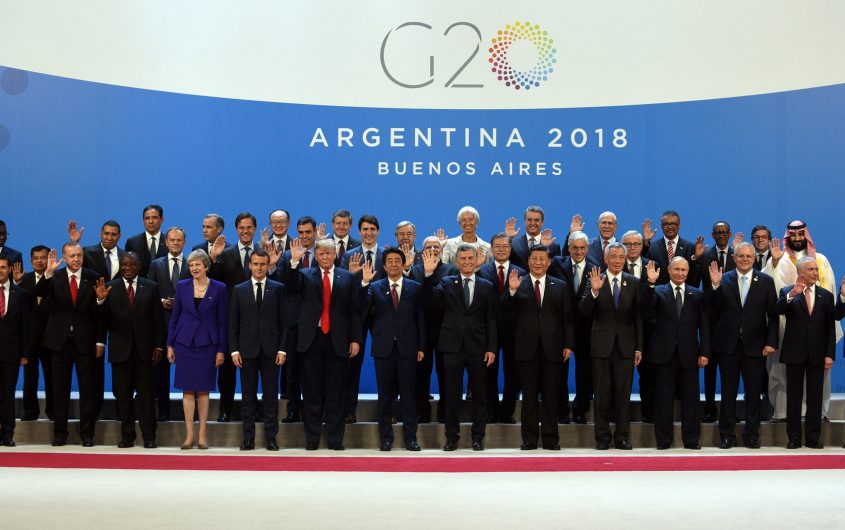
G20 Argentina via Flickr
A G20 Reality Check Eases Global Trade Tensions

Peter S. Rashish
Vice President; Director, Geoeconomics Program
Peter S. Rashish, who counts over 30 years of experience counseling corporations, think tanks, foundations, and international organizations on transatlantic trade and economic strategy, is Vice President and Director of the Geoeconomics Program at AICGS. He also writes The Wider Atlantic blog.
Mr. Rashish has served as Vice President for Europe and Eurasia at the U.S. Chamber of Commerce, where he spearheaded the Chamber’s advocacy ahead of the launch of the Transatlantic Trade and Investment Partnership. Previously, Mr. Rashish was a Senior Advisor for Europe at McLarty Associates, Executive Vice President of the European Institute, and a staff member and consultant at the International Energy Agency, the World Bank, UN Trade and Development, the Atlantic Council, the Bertelsmann Foundation, and the German Marshall Fund.
Mr. Rashish has testified before the House Financial Services Subcommittee on International Monetary Policy and Trade and the House Foreign Affairs Subcommittee on Europe and Eurasia and has advised three U.S. presidential campaigns. He has been a featured speaker at the Munich Security Conference, the Aspen Ideas Festival, and the European Forum Alpbach and is a member of the Board of Directors of the Jean Monnet Institute in Paris and a Senior Advisor to the European Policy Centre in Brussels. His commentaries have been published in The New York Times, the Financial Times, The Wall Street Journal, Foreign Policy, and The National Interest, and he has appeared on PBS, CNBC, CNN, NPR, and the BBC.
He earned a BA from Harvard College and an MPhil in international relations from Oxford University. He speaks French, German, Italian, and Spanish.
Less is more, said the German Bauhaus architect Ludwig Mies van der Rohe. That may be the inspiration behind the fewer than 100 words the G20 leaders devoted to trade in their joint declaration at the weekend summit in Buenos Aires.
Given the turmoil preceding last year’s gathering in Hamburg, and President Trump’s disavowal of the communiqué following the G7 summit in Canada in June, there could have been worse outcomes than the terse and unsentimental appraisal of the state of world trade agreed in Argentina.
“We renew our commitment to work together to improve a rules-based international order that is capable of effectively responding to a rapidly changing world,” the leaders announced up front.
Further down come a few more specifics, including one important critique:
“International trade and investment are important engines of growth, productivity, innovation, job creation and development. We recognize the contribution that the multilateral trading system has made to that end. The system is currently falling short of its objectives and there is room for improvement. We therefore support the necessary reform of the WTO to improve its functioning. We will review progress at our next Summit.”
That’s it, but perhaps that’s enough. Yes, the traditional promise to fight protectionism is absent, but so is the language in last year’s declaration about “reciprocal” trade and investment frameworks. It’s good to oppose protectionism, but reciprocity-based trade is not the way to do it; rules-based trade is. And that idea does get a positive mention in the Buenos Aires declaration, as do the multilateral trading system and the World Trade Organization.
That the system is “falling short of its objectives” should be a surprise to no one, owing to the diversity of its members, above all a huge Chinese state-capitalist economy that the WTO’s founders never envisioned. While swift reform of the WTO will be difficult, it’s welcome that both the United States and China agreed to the text.
But the leaders’ declaration wasn’t where the action was on trade at the G20; that came later at the dinner between Trump and Chinese President Xi and then on Trump’s plane ride home with his announcement that the U.S. would pull out of the existing NAFTA agreement now that the American, Canadian, and Mexican leaders inked its successor, the USMCA, in Buenos Aires.
Trump and Xi arrived at a temporary truce: no raising of U.S. tariffs from 10 to 25 percent on $200 billion of Chinese goods on January 1 in return for a Chinese commitment to buy an unspecified amount of U.S. products, and an agreement to start talks on Chinese intellectual property, technology transfer, and cyber policies.
More Chinese imports of agricultural goods, if they materialize, will help Trump regain some temporary favor among farmers hurt by the tit-for-tat tariff war with China.
And while there’s nothing wrong with U.S. negotiations with China on its trade and economic practices, a bilateral approach won’t be enough to nudge Beijing to change. That will only happen if the White House works with the European Union, Japan, Australia, Canada, Mexico, and other like-minded countries to build an enduring common front. But that way there would be less glory for a U.S. president who does not naturally share the spotlight.
Judged against expectations, both the communiqué and the Trump-Xi dinner were net positives. Not so Trump’s surprise announcement that the U.S. will withdraw from NAFTA. That means if the Congress does not approve the new USMCA within six months the rules that tie together North America as an efficient manufacturing platform will disappear.
With this step, the president has increased the pressure on the incoming House Democratic majority on trade policy. But it’s not only about granting or denying the White House a “win” on the USMCA. More important will be how the party situates its vote on the deal within a larger strategy for trade policy in promoting U.S. prosperity. That needs to be one of Speaker Pelosi’s first orders of business now.








